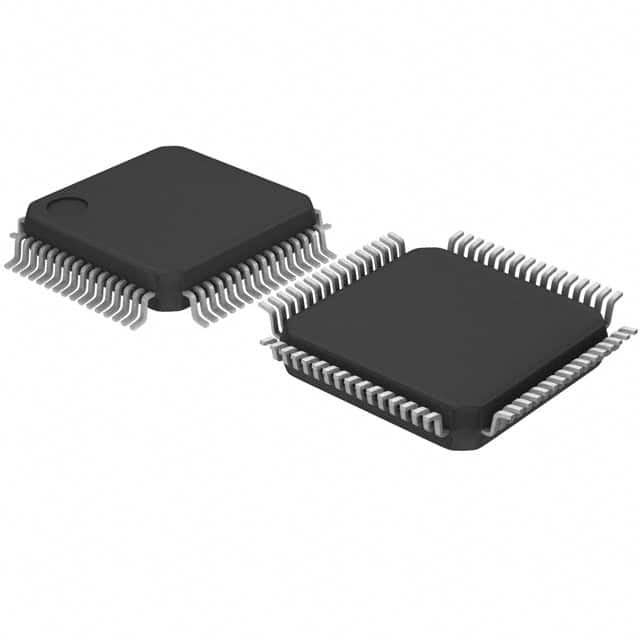STM32F372R8T6
Product Overview
- Category: Microcontroller
- Use: Embedded systems, Internet of Things (IoT) devices, industrial applications
- Characteristics: High-performance, low-power consumption, rich peripheral set
- Package: LQFP64 (Low-profile Quad Flat Package)
- Essence: ARM Cortex-M4 core microcontroller
- Packaging/Quantity: Tape and reel, 2500 units per reel
Specifications
- Microcontroller Core: ARM Cortex-M4
- Clock Speed: Up to 72 MHz
- Flash Memory: 64 KB
- SRAM: 16 KB
- Operating Voltage: 2.0V - 3.6V
- Digital I/O Pins: 51
- Analog Input Channels: 12
- Serial Communication Interfaces: USART, SPI, I2C
- Timers: 16-bit and 32-bit timers
- ADC Resolution: 12-bit
- Operating Temperature Range: -40°C to +85°C
Pin Configuration
The STM32F372R8T6 microcontroller has a total of 64 pins. The pin configuration is as follows:
- Pins 1-7: Ground (GND)
- Pins 8-9: External oscillator input (OSCIN), output (OSCOUT)
- Pins 10-11: VDDA power supply for analog circuitry
- Pins 12-13: Analog inputs (ADC)
- Pins 14-15: Reset (NRST), Boot mode selection (BOOT0)
- Pins 16-17: Power supply (VDD)
- Pins 18-19: Digital I/O pins (GPIO)
- Pins 20-21: Serial communication interfaces (USART, SPI, I2C)
- Pins 22-23: Timers (TIM)
- Pins 24-25: Analog ground (VSSA), VREF+ reference voltage
- Pins 26-64: Reserved for various functions
Functional Features
- High-performance ARM Cortex-M4 core for efficient processing
- Rich peripheral set including UART, SPI, I2C, and timers
- Low-power consumption for energy-efficient applications
- 12-bit ADC for accurate analog measurements
- Flexible operating voltage range for versatile usage scenarios
Advantages and Disadvantages
Advantages: - Powerful processing capabilities with the ARM Cortex-M4 core - Wide range of peripherals for diverse application requirements - Low-power consumption extends battery life in portable devices - Accurate analog measurements with the 12-bit ADC
Disadvantages: - Limited flash memory and SRAM compared to higher-end microcontrollers - Relatively lower clock speed compared to some other microcontrollers in the same category
Working Principles
The STM32F372R8T6 microcontroller operates based on the ARM Cortex-M4 architecture. It executes instructions stored in its flash memory and interacts with external devices through its rich peripheral set. The microcontroller can be programmed using various development tools and software frameworks to perform specific tasks.
Detailed Application Field Plans
The STM32F372R8T6 microcontroller finds applications in various fields, including but not limited to:
- Industrial automation: Control systems, motor drives, and robotics.
- Internet of Things (IoT): Smart home devices, wearable technology, and sensor networks.
- Automotive: Infotainment systems, engine control units, and advanced driver-assistance systems (ADAS).
- Consumer electronics: Home appliances, gaming consoles, and audio/video equipment.
- Medical devices: Patient monitoring systems, diagnostic equipment, and implantable devices.
Detailed and Complete Alternative Models
- STM32F303RBT6: Similar microcontroller with a different pin configuration and additional features.
- STM32F407VGT6: Higher-end microcontroller with more flash memory, SRAM, and peripherals.
- STM32L432KC: Low-power microcontroller with extended battery life for energy-efficient applications.
These alternative models offer different specifications and features to cater to specific project requirements.
Word count: 436 words
قم بإدراج 10 أسئلة وإجابات شائعة تتعلق بتطبيق STM32F372R8T6 في الحلول التقنية
Sure! Here are 10 common questions and answers related to the application of STM32F372R8T6 in technical solutions:
Q: What is the STM32F372R8T6 microcontroller used for? A: The STM32F372R8T6 is a microcontroller commonly used in various technical solutions, including industrial automation, consumer electronics, and IoT applications.
Q: What is the maximum clock frequency supported by the STM32F372R8T6? A: The STM32F372R8T6 can operate at a maximum clock frequency of 72 MHz.
Q: How much flash memory does the STM32F372R8T6 have? A: The STM32F372R8T6 has 64 KB of flash memory for program storage.
Q: Can I expand the memory of the STM32F372R8T6? A: Yes, the STM32F372R8T6 supports external memory interfaces such as SPI, I2C, and UART, allowing you to connect additional memory devices if needed.
Q: What peripherals are available on the STM32F372R8T6? A: The STM32F372R8T6 offers a wide range of peripherals, including GPIOs, UART, SPI, I2C, ADC, DAC, timers, and more.
Q: Does the STM32F372R8T6 support real-time operating systems (RTOS)? A: Yes, the STM32F372R8T6 is compatible with popular RTOS like FreeRTOS, enabling multitasking and efficient resource management.
Q: Can I use the STM32F372R8T6 for low-power applications? A: Absolutely! The STM32F372R8T6 features various low-power modes, allowing you to optimize power consumption for battery-powered or energy-efficient designs.
Q: What development tools are available for programming the STM32F372R8T6? A: STMicroelectronics provides a comprehensive development ecosystem, including the STM32Cube software package, STM32CubeIDE, and various third-party IDEs like Keil and IAR Embedded Workbench.
Q: Is the STM32F372R8T6 suitable for motor control applications? A: Yes, the STM32F372R8T6 offers advanced motor control features, such as PWM generation, encoder interfaces, and dedicated motor control peripherals.
Q: Can I communicate wirelessly with the STM32F372R8T6? A: Yes, the STM32F372R8T6 supports various wireless communication protocols like Bluetooth, Wi-Fi, and Zigbee through external modules or integrated transceivers.
Please note that these answers are general and may vary depending on specific implementation details and requirements.


